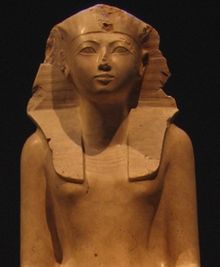Winner of the Fall 2016 StMU History Media Award for
Best Introductory Paragraph
Article with the Best Title
Queen B said it best when she sang the infamous line, “Who run the world? Girls.”1 When looking back to history, men are seen as better and treated better than women. A long time ago, in ancient Egypt, women of the royal family served as guides to young male rulers. But there was one unconventional case where a woman defied the odds and obtained the role of pharaoh.

Queen Hatshepsut was the oldest daughter of Thutmose and his Great Royal Wife, Queen Ahmose. Thutmose, like most males who held power during those times, had another wife with whom he had a son. His name was Thutmose II; when he was at the age of eight and Hatshepsut was thirteen, they were wed, despite the fact of their shared blood line. When their father passed, Thutmose II assumed the position of pharaoh. While he was pharaoh, they birthed a daughter, but every male in power needs a male heir. Since she was unable to produce a son, he and a minor wife, Iris, conceived a son who became Thutmose III. Thutmose II and Hatshepsut reigned in Egypt until his death. The next male in line was Thutmose III, but Hatshepsut’s step child was too young to fulfill the position of pharaoh, so she ruled in his stead. On that note, even when he did become old enough to rule, she refused to turn over the power to him, and she remained in power. That is when she began her transition from Queen Hatshepsut to Pharaoh Hatshepsut.2

The Queen herself had a headdress made that included a beard and some male characteristics.3 She did not go out of her way to keep her gender a secret, for she did include feminine touches to her attire. Masculinity of course was respected more and was associated with power, which is why she sometimes took on such characteristics. Despite being a female ruler, at that time (and still today) people would not expect such a flourishing reign. Beginning in 1473 B.C.E. and ending in 1458 B.C.E., under her control wealth was accumulated. When it came to the protection of Egypt, she engaged in successful warfare against her invaders. She also had an extensive building program in which a temple of devotion to their sun god, Amun, was erected. Prosperity and wealth also came about because she sent ships on expeditions to foreign lands to obtain riches. These included ivory, ebony, gold, and trees. Now, why would they bring back trees? Whenever they had temple ceremonies, trees would be burned by the tons for fragrant incense.4
All good things must come to an end, and this particular ending is death. After she died, successors attempted to erase the fact that a female had become pharaoh.5 Even with this attempt to erase history, she is still known as a successful pharaoh to this day. She brought about protection, prosperity, and plenitude during her time as king. She did not serve as a guide to a young male pharaoh, but she showed how one must rule during her reign.
- Beyoncé, “Run the World (Girls),” in 4, Columbia Records, 2011. ↵
- Ann Macy Roth, “Models of Authority: Hatshepsut’s Predecessors in Power,” in Hatshepsut: From Queen to Pharaoh, ed. Catharine H. Roehrig, Renee Dreyfus, and Cathleen A. Keller (New York: Metropolitan Museum of Art, 2005), 10. ↵
- Roth, “Models of Authority: Hatshepsut’s Predecessors in Power,” 10. ↵
- Rupert Matthews, DK Eyewitness Books: Explorer (DK Publishing, 2012), 8. ↵
- Angela Murock Hussein, “Legacy of a Female Pharaoh,” Calliope 19, no. 1 (September 2008): 48. ↵



85 comments
Oscar Portillo
The Ancient Egyptian society has always been captivating and it is due to people like Hatsheput. Well written article the dynamic was interesting because there was a feeling that maybe a woman could not rule which in this case was not. Additionally, she was far more successful than a good number of other male Pharaohs. In history it is rare to hear of successful females in positions of power. Fortunately, women have many more opportunities now than in the Ancient world and could one day be viewed as favorably as men have been for millenniums. We see this in the U.S. where we could have a female President as soon as 2021 and would thus join an elite echelon of women throughout history.
Erik Rodriguez
Awesome article! I truly never knew about Queen/Pharao Hatshepsut. It is amazing how she never gave up her power, and now we consider her the greatest Pharao! I think it was wise of her to add male features to her appearance so she would have more respect, but she still stayed true to herself by keeping her feminine features.
Great article!
Yesenia Cardenas
Great opening sentence! Queen B was such and inspirational woman. She stood up for her self towards others and I wish woman today would continue fight like she did. Sadly woman in power today are looked down on just because of their sex. This is such an empowering article, outstanding job!
Mariana Sandoval
Yes, Queen B! The only question I had from the article was why they allowed her to stay in the position of Pharaoh? Could they not have assassinate her or was that taboo? I’m definitely not saying that I would have wanted her to be assassinated, but I find it interesting that she was able to keep her reign because assassination seems like a “go to” when the masses of people don’t like their leader. I knew nothing about this topic before today so this was a very informative article on a topic that most people probably don’t know about.
Rachel White
From the title to the end, this article kept me engaged and wanting to keep reading. You did a great job of really gaining the reader’s attention with your first line and you kept it throughout. It is quite disgusting to think about a time in which it did not matter if you were only thirteen years old to be married off; and it didn’t matter if your future spouse shared your bloodline. Both of those statements make me want to run to the bathroom and throw up, but anyways! It is amazing that she did not let that stop her and she did not conform to the society’s expectation of women at the time. She stood out, and she will always be remembered for doing so.
Jezel Luna
I loved the way you started your paper! Queen B “Who runs the world? Girls!” This quote so perfectly depicts the undeniable truth that in the end it is undoubtedly females who run the world. When you mentioned that “women served as guides to young male rulers” it immediately made me think of the famous saying “Behind every successful man is a great woman”. I admire Pharaoh Hatshepsut for her impeccable dedication and persistence in changing the stereotypical views of women in power.
Mia Diaz
I loved the opening of this article! Especially because before reading it, I knew absolutely nothing about Queen Hatsheput. I absolutely loved how she stood up for herself and refused to give up her crown. I’m sure doing that during that time era would not have been easy. I’m not sure if I would have the courage to fight the strength and image of men back then. Obviously her courage and bravery paid off because Egypt flourished under her reign. I think this is an excellent historical example of the capabilities of women and all they can accomplish!
Jocelyn Alvarez Bibian
This is a really good article Soki! I love the fact that you introduced your article with the lyrics from a woman who has also shown that girls do “rule the world.” This article is truly empowering and let all women know that they can also accomplish what they want. It is really interesting how Queen Hatshepsut implemented masculine characteristics to her headdress to show power. I also admire her determination to refuse to give the throne to her stepson. Her accomplishments make clear that she indeed was a successful pharaoh and that ruling an empire was not exclusive for men. Good job!
Jacob Hall
Your article was really good and I truly enjoyed that you brought up the fact that in the Egyptian society men were viewed to be the only ones who had the true right to rule, and that you mentioned how Hatshepsut made herself look and be portrayed as a male ruler.
Ivanna
You can never go wrong with Queen B. Best hook on an article so far. Extremely informative and empowering. Especially since the reign of Queen Hatsheput brought wealth and prosperity to Egypt. Thus, proving that a women can take over a “man’s role” and be successful.